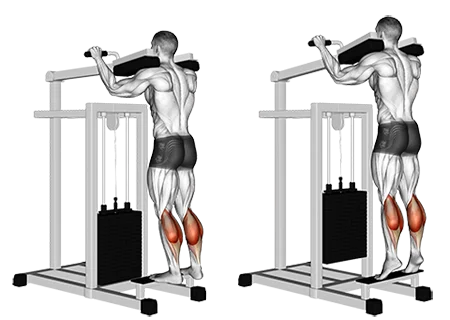Introduction
The "Standing Machine Calf Raise" is a resistance training exercise that primarily targets the lower leg muscles, specifically the gastrocnemius and soleus. This exercise strengthens and tones the calf muscles, improving ankle stability and overall lower body strength. It's particularly beneficial for individuals aiming to enhance their athletic performance, especially in sports requiring jumping or running, due to its impact on vertical jump height and speed.
Muscles Worked
- Primary: Gastrocnemius and Soleus (calf muscles)
- Secondary: Tibialis Anterior (shin muscle in front of the leg), Peroneus Longus and Brevis (smaller muscles on the outer side of the lower leg)
How to Do It (Step-by-Step)
- Stand with your feet hip-width apart, holding onto a stationary object for balance if needed, and place the balls of both feet on the raised platform of a standing calf raise machine.
- Push through your heels to lift your body up by contracting your calf muscles, keeping your knees slightly bent.
- Lower slowly back down with control, flexing your ankles, until your calves are fully stretched but not touching the platform.
Tip: Engage your core and keep your back straight throughout the exercise to prevent injury and maintain proper form.
Rep & Rest Guidelines
- Strength: 4–6 reps, 2–3 min rest
- Hypertrophy: 8–12 reps, 60–90 sec rest
- Endurance: 12–20 reps, 30–60 sec rest
Using the Volym app's Auto Progression feature can help you effectively adjust your weights for optimal progress.
For consistent and effective rest periods during your workout, use the Rest Timer in the Volym app.
Form Tips
- Maintain an upright posture with your shoulders rolled back and core engaged. This ensures the work is focused on your calves and not other muscle groups.
- Stand on the balls of your feet, keeping your heels off the ground throughout the exercise. This isolates the calf muscles for maximum activation.
- Keep your knees slightly bent, and avoid locking them out or bending them excessively. This helps to reduce strain on the joints and ensures a smooth, controlled movement during the raise.
When to Use It
- Improving lower body balance and stability in functional fitness exercises
- Enhancing power and explosiveness for sports like basketball, soccer, and volleyball
- Building calf muscle mass for aesthetic purposes, such as bodybuilding competitions
Workout History can help you track your progress in these scenarios.
The standing machine calf raise primarily works the gastrocnemius (the visible part of the calf) and soleus muscles in the lower leg.
For optimal results, perform 3-4 sets of 8-12 repetitions per set with a challenging weight.
Yes! Use a full range of motion by fully extending and flexing your ankles to get the most out of each rep.
Using straps or wrist hooks may take some stabilization work away from the calves. It's recommended to avoid them whenever possible.
Include calf raises in your workout routine 2-3 times per week for best results.

